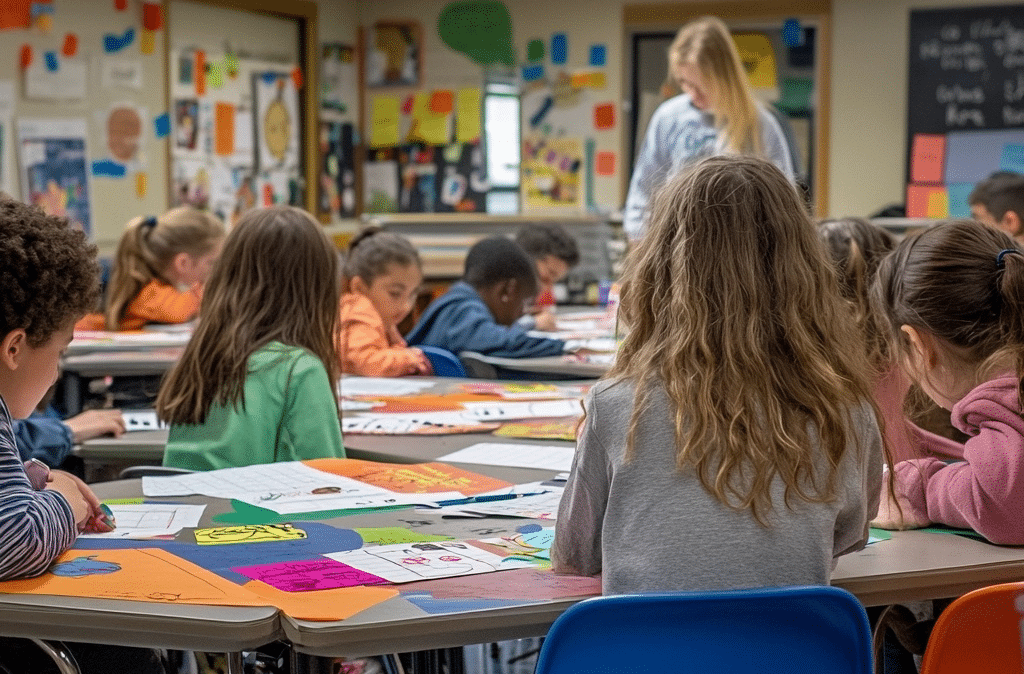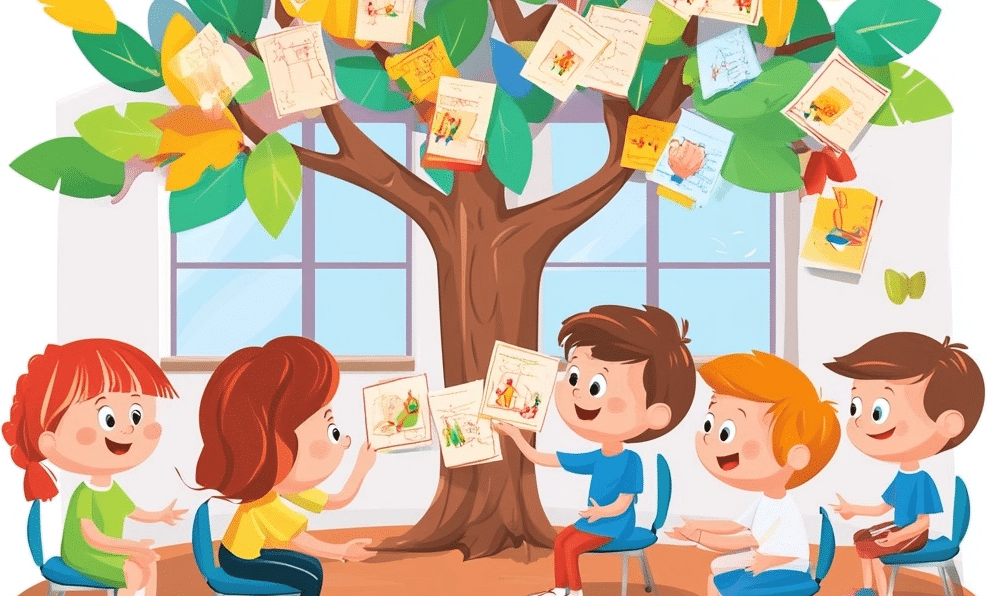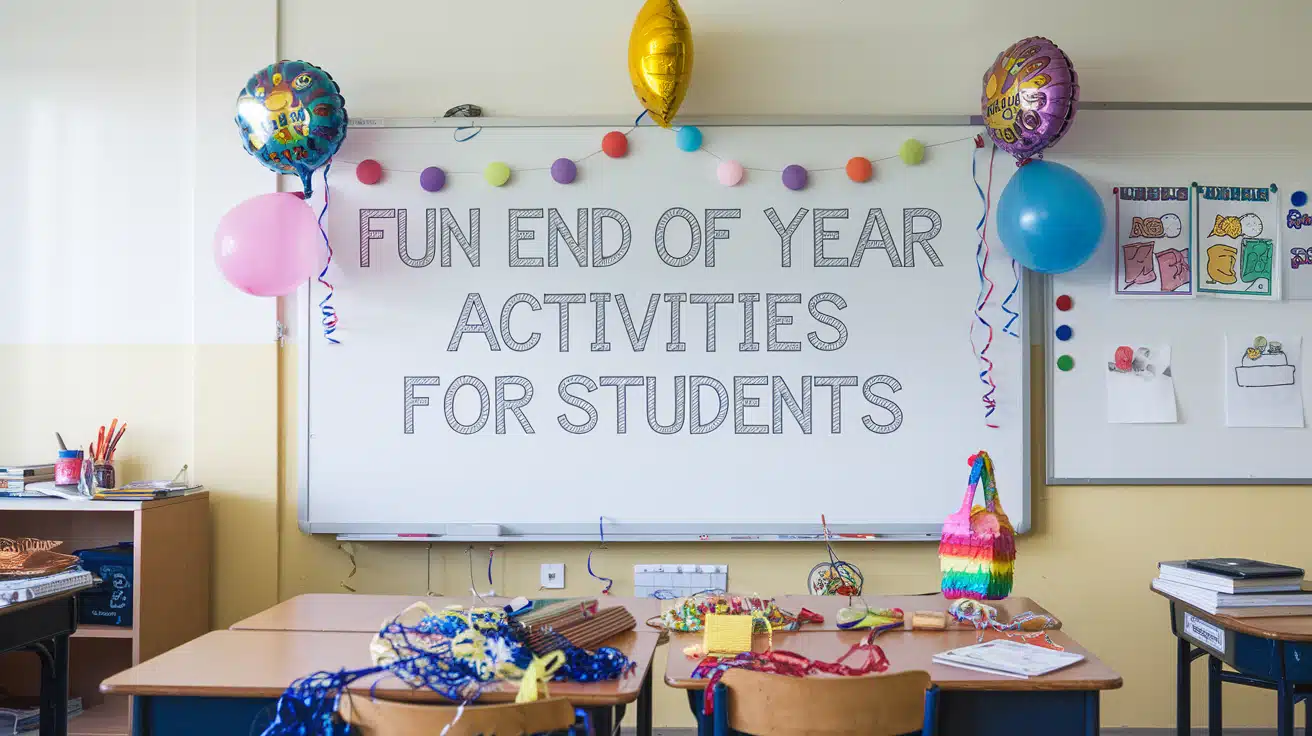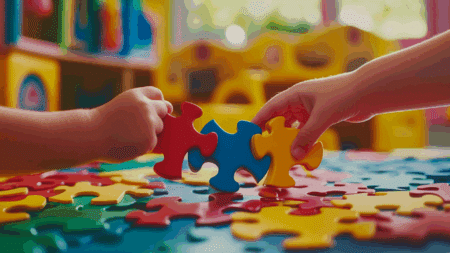Do you remember making a memory scrapbook in elementary school? The most memorable school moments usually happened during end-of-year activities, when the pressure of tests fades and celebration starts.
These times help recognize everyone’s hard work and achievements throughout the academic process. When students participate in end-of-year celebrations, they build stronger bonds with classmates and teachers, creating a sense of community that improves their overall school experience.
They allow everyone to transition into summer break with positive feelings and a sense of accomplishment. Whether through awards ceremonies, creative projects, outdoor games, or heartfelt goodbyes, these celebrations acknowledge the worth of the educational journey.
In this blog, we’ll tell you fun end-of-year activities that will make the final days of school meaningful and memorable for everyone involved.
Why End-of-Year Activities Matter
End-of-year activities help students understand their own growth and feel good about what they’ve learned.
These special moments let kids look back on their school year and see how much they’ve changed. When students do fun activities together, they learn important skills like working as a team and understanding their feelings.
These experiences create happy memories that students will remember long after the school year ends. By doing these activities, teachers can help students feel less worried about the end of the school year and more excited about what comes next.
It’s a chance to celebrate all the hard work, friendships, and learning that happened throughout the year.
Fun End-of-Year Activities for Students
Looking for simple and fun ways to wrap up the school year? These end-of-year activities help students celebrate, reflect, and enjoy their last days together.
1. Class Memory Book

Each student creates a page with their favorite memories, photos, and reflections from the year. Compile these individual pages into a collaborative book that showcases everyone’s perspective.
To help students organize their thoughts, include prompts like “My favorite field trip,” “Something new I learned,” or “My best friend this year.”
Bind the pages together and let students sign each other’s pages for an extra personal touch. This keepsake will be something they can look back on for years to come, preserving their childhood memories in a tangible format.
2. Talent Show

Students showcase their talents, whether it’s singing, dancing, or a trick. This event celebrates the diverse abilities within your classroom that may not always get highlighted during academic work.
Encourage all forms of talent – from traditional performances like singing to unique skills like speed-solving a Rubik’s cube or telling jokes.
Create a supportive atmosphere where students feel comfortable sharing their passions. If they’re nervous about performing solo, consider having them work in small groups.
End with a standing ovation for everyone who participated, emphasizing courage and self-expression.
3. Memory Wall

A bulletin board where students post drawings, writings, or photos that reflect their year. Transform a classroom wall or hallway space into a visual celebration of the school year’s journey.
Provide colorful paper, markers, and tape for students to create and display their contributions. Include categories like “Proudest Moment,” “Biggest Challenge Overcome,” “Funniest Memory,” and “New Friends Made”.
Encourage creativity by allowing various formats—poems, cartoons, short stories, or photo collages.
This collaborative display powerfully reminds students of shared experiences and individual growth, and they enjoy seeing their contributions as part of the larger class story.
4. Field Day

A day of outdoor games and activities like races, tug-of-war, and relays. This beloved tradition combines physical activity, friendly competition, and outdoor fun to celebrate the approaching summer.
Plan a variety of stations to accommodate different physical abilities and interests. Incorporate team events that mix students from different social groups to build new connections.
Consider a theme like “Olympic Games” or “Carnival” to enhance the festive atmosphere. Provide plenty of water, shade spots, and rest periods to ensure everyone stays comfortable while making memories in the sunshine.
5. Classroom Olympics

Set up stations for different challenges (like jumping jacks or hula hooping) where students compete in teams. Transform your classroom into an Olympic arena with stations that test different skills and abilities.
Include physical challenges like paper airplane throwing distance or cotton ball scooping races. Create mixed-ability teams with creative country names and flags they design themselves.
Track points on a leaderboard, but focus on participation and effort rather than winning. Hold an opening ceremony with a torch relay using a paper flame, and award handmade medals during a closing ceremony.
6. Movie Day

To create a special cinema experience, darken the classroom, arrange comfortable seating with pillows or cushions from home, and serve simple treats like popcorn.
Select a film. Before watching, give students a few reflection questions to consider, and afterward, hold a brief discussion about connections they noticed to their own experiences.
For younger grades, consider showing a compilation of short films or breaking a longer movie into sections with movement breaks.
7. Outdoor Scavenger Hunt

Design a hunt that encourages exploration of the school grounds while incorporating learning objectives. Instead of just finding objects, include tasks like “Find three different types of leaves and identify the trees they come from.”
Provide clipboards, pencils, and collection bags for gathering items. For younger students, use pictures alongside words.
Structure the hunt as either a collaborative team effort or a friendly competition with simple prizes for all participants.
8. STEM Challenges

Set up a day of hands-on problem-solving that showcases the scientific and engineering skills students have developed throughout the year. Prepare challenges appropriate to grade level.
Provide basic materials at each station and clear instructions with the engineering design process outlined. Encourage teams to document their approaches, failures, and successes through sketches and notes.
Conclude with a “STEM Showcase” where teams present their solutions and reflect on their thinking process.
9. Ice Cream Social

Host a social event where students build their own ice cream sundaes. Transform your classroom into an ice cream parlor with a variety of flavors and toppings set up buffet-style.
Consider accommodating dietary restrictions with non-dairy options or alternative treats. Enhance the experience with themed decorations, upbeat music, and perhaps even paper hats or aprons.
Take photos of the creative sundaes and smiling faces to include in year-end communications with families.
10. Thank You Notes

Students write letters to teachers, staff, or even each other expressing gratitude for the year. Provide quality stationery or card-making materials along with examples of sincere, specific thank-you messages.
Guide students to think beyond generic statements by asking prompts like “What is something this person taught you that you’ll never forget?” or “How did this person make your day brighter?”
Encourage notes to various school community members—from the principal and custodian to the cafeteria staff and crossing guards. For peer-to-peer notes, consider a system where each student writes something positive about every classmate.
11. Summer Reading Challenge

Set up a fun reading goal for the summer with a reward system to encourage continued learning.
Work with students to establish reasonable goals based on their reading levels and interests. Perhaps use a visual tracker like a reading bingo card or a paper chain in which each link represents a book.
Collaborate with the school or local librarian to suggest age-appropriate book lists that include diverse genres, cultures, and difficulty levels.
Establish simple rewards that can be claimed when school resumes, or partner with local businesses for incentives.
12. End-of-Year Read Aloud

Read a book that reflects on the year or looks forward to the future. Select a meaningful story that resonates with themes of growth, transition, or new beginnings.
Create a special atmosphere for this final shared reading experience—perhaps outside under a tree, in a circle of cushions on the floor, or with special lighting and soft background music.
Choose age-appropriate titles. For older students, consider short stories or poems about change and possibility.
After reading, facilitate a thoughtful discussion connecting the text to students’ own experiences and feelings about moving forward.
13. Awards Ceremony

Celebrate each student’s accomplishments and strengths with personalized awards. Reflect on each child’s year, identifying specific qualities that deserve acknowledgment.
Create attractive certificates with thoughtful, specific comments rather than generic praise. Consider inviting families or other classes to attend, creating a special atmosphere with decorations and perhaps light refreshments.
Present each award with a brief, heartfelt speech highlighting concrete examples of why the student earned the recognition.
14. Classroom Clean Up

Students clean the classroom together, making it fun with music or a competition for the best job. Create a playlist of upbeat songs students have enjoyed throughout the year.
Divide the class into small teams assigned to different areas—book corner, supply cabinets, display boards, or desk clusters. Provide appropriate cleaning supplies, gloves, and clear instructions for each zone.
Take before-and-after photos to celebrate the transformation.
15. Time Capsule

Students write down their thoughts about the year and put them in a time capsule to open next year. Provide a template with thoughtful prompts like “My favorite subject is…” “Next year, I hope to learn…” “My current goals are…” and “When I grow up, I want to…”
Include physical measurements, current interests, and predictions for the future. Have students contribute small mementos that represent their year.
Use decorated boxes, large manila envelopes, or even clean paint cans as containers. Store the time capsules somewhere secure, with a plan for returning them to students the following year.
16. End of Year Survey

Create a thoughtful questionnaire that serves both as a reflection tool for students and valuable feedback for your teaching practice.
Design age-appropriate formats – perhaps emoji ratings for younger students or more nuanced questions for older ones.
Include questions about favorite units of study, most impactful learning experiences, classroom procedures that worked well or needed improvement, and social aspects of the class community.
17. Last Day of School T-shirts

Create custom shirts for the class to wear on the last day, featuring a fun design or slogan. Through a collaborative design process, turn plain T-shirts into meaningful mementos.
Weeks before the end of school, brainstorm themes or slogans that represent the class’s unique identity, inside jokes, or significant experiences.
For a simpler approach, pre-print the design and have students personalize it with signatures. Wearing these shirts on the last day creates a visible symbol of unity and provides a lasting keepsake.
18. Summer Fun Box

The Summer Fun Box is a thoughtful way to extend the classroom connection into the summer break. Teachers can create personalized care packages that keep students engaged and excited about learning during their time off.
By carefully selecting items that are both entertaining and educational, educators can help prevent summer learning loss while giving students something special to look forward to.
The box might include practical items like reading suggestions, local activity guides, and small educational games, along with a personalized note that shows the teacher’s continued support and care.
19. Photo Time

Capturing memories is a powerful way to commemorate the school year. Photo time allows students to create lasting mementos of their classroom experience, friendships, and personal growth.
Teachers can approach this activity creatively by setting up a special photo area with a backdrop, taking both individual and group photos, and capturing candid moments throughout the day.
These photographs can be compiled into a class memory book, shared with students, or even used to create an end-of-year slideshow that celebrates the year’s journey.
20. Balloon Greeting

Transforming the classroom into a festive environment can immediately lift students’ spirits on the last day of school.
Balloons create a celebratory atmosphere that makes the day feel special and memorable. Teachers can involve students in the decoration process, perhaps writing encouraging messages on the balloons or using them as part of a collaborative activity.
The colorful decorations serve as a visual representation of the joy and accomplishment of completing another school year.
21. Writing Activity

Reflection is a powerful tool for personal growth and understanding. This writing activity encourages students to look back on their year, acknowledging their achievements, challenges, and personal development.
By providing thoughtful prompts, teachers can help students articulate their experiences, recognize their learning journey, and set intentions for the future.
This activity not only serves as a memory keeper but also helps students develop critical self-reflection skills.
22. Skittles Writing Activity

This creative writing exercise turns a simple bag of Skittles into a unique storytelling tool.
By assigning each color a specific memory or reflection prompt, students are encouraged to think deeply about their school year playfully and engagingly.
The activity combines the excitement of a treat with meaningful reflection, making the writing process both fun and introspective. It’s an excellent method for students who might find traditional writing activities challenging or intimidating.
23. Draw It Activity

Visual expression can be just as powerful as written reflection.
The Draw It Activity allows students to illustrate their school year experiences, catering to different learning styles and creative abilities.
By providing specific prompts and a drawing template, teachers can guide students in creating meaningful artwork that captures their memories, emotions, and personal growth. This activity is particularly beneficial for visual learners and can be a less intimidating way to reflect on the year.
24. Summer Ice Cream Science Experiment

This activity combines fun with learning, turning a delicious treat into an educational experience. Students explore scientific concepts like freezing point depression while creating their own ice cream.
The hands-on nature of the experiment makes complex scientific principles more accessible and enjoyable.
It’s a perfect way to end the year on a high note, demonstrating that learning can be both fun and delicious.
25. Write Letters to Favorite School Staff

Expressing gratitude is an important social-emotional skill.
This activity encourages students to reflect on the support they’ve received and acknowledge the staff members who have made a significant impact on their lives.
By writing heartfelt thank-you letters, students practice communication skills, develop empathy, and learn the importance of appreciating those who help them.
It’s also a wonderful way for staff members to feel valued and recognized.
26. Write Letters to Next Year’s Class

Passing down wisdom and advice creates a sense of continuity and community within the school.
Students get to reflect on their own experiences and consider what would have been helpful for them to know at the beginning of the year.
This activity helps students recognize their growth, develop empathy, and feel pride in their achievements. It also provides valuable insights for incoming students.
27. Classroom Potluck

A potluck is more than just sharing food – it’s a celebration of diversity, community, and personal expression.
Students bring dishes that are meaningful to them, often sharing stories about their cultural backgrounds or family traditions.
This activity promotes understanding, respect, and appreciation for different cultures and personal experiences. It’s a delightful way to end the year by bringing the class together through the universal language of food.
28. Year in Review Video

Creating a video compilation allows students to relive the highlights of their school year.
It’s a multimedia approach to reflection that can include interviews, event highlights, academic achievements, and fun moments.
The process of selecting and editing content helps students appreciate their collective journey and individual growth. It provides a lasting memory that can be shared with families and revisited in years to come.
29. Outside Day

It provides an opportunity for students to learn outside the classroom, bond as a group, and create lasting memories.
Whether visiting a local museum, park, or special event, the trip offers a break from routine and a chance to apply learning in a real-world context.
It’s a rewarding way to celebrate the year’s achievements and learning.
30. Mindfulness Crafting

It is very important to end the year with a focus on mental well-being.
Mindfulness crafts help students learn stress-management techniques while creating something tangible.
Activities like making stress balls or paper lanterns provide a creative outlet and introduce valuable relaxation skills. This approach acknowledges the emotional journey of the school year and equips students with tools for managing stress.
31. Memory Jar

The Memory Jar is a collective time capsule of the class’s experiences.
By having students write down their favorite moments, the activity encourages reflection, gratitude, and appreciation for shared experiences.
The physical jar becomes a symbol of the class’s journey, with each slip of paper representing a unique memory. Reading these memories together can be a powerful and emotional experience that brings the class closer together.
32. Class Family Circle

The final activity brings the class together in a meaningful, supportive way. Sitting in a circle promotes equality, active listening, and mutual respect.
Students get a chance to express gratitude, share memorable moments, and offer well-wishes to their classmates.
This activity concludes the school year by celebrating the community they’ve built and the individual growth they’ve experienced.
33. Gratitude Tree

By creating paper leaves and writing down things they’re thankful for, students practice mindfulness and reflection.
The tree becomes a beautiful classroom display that showcases the collective appreciation of the class.
This activity not only serves as a decorative element but also helps students develop emotional intelligence and gratitude, important skills that extend far beyond the classroom.
34. Summer Bucket List

Creating a summer bucket list allows students to dream, plan, and set personal goals for their upcoming break.
This activity encourages creativity, forward-thinking, and personal exploration.
Students can include a mix of fun activities, learning opportunities, personal challenges, and family experiences.
The process of crafting this list helps students maintain a sense of excitement and purpose during the summer months, preventing the potential learning loss that can occur during extended breaks.
35. Creative Writing Prompts

Creative writing prompts provide an open canvas for students to explore their imagination and storytelling abilities.
Teachers can encourage students to dream, reflect, and express themselves freely by offering thought-provoking prompts like “If you could go anywhere this summer…”
This activity nurtures creativity, improves writing skills, and gives students a chance to share their inner thoughts and aspirations. It’s an excellent way to end the year on an imaginative and inspirational note.
36. Memory Quilt

The Memory Quilt is a collaborative art project that turns individual memories into a collective masterpiece.
Each student contributes a square with a personal drawing or message, creating a tangible representation of the class’s shared experience.
This activity combines creativity, personal reflection, and group collaboration. The resulting quilt becomes a cherished keepsake that captures the class’s unique personalities and memories, symbolizing their time together.
37. Water Balloon Toss

Sometimes, the best way to end the school year is with pure, unbridled fun. A water balloon toss or water relay race provides a refreshing and exciting conclusion to the academic year.
This activity offers a chance for students to cool off, laugh together, and create memorable last-day experiences.
Beyond the fun, such activities help build teamwork and coordination and provide a much-needed release of energy as students transition into summer break.
38. Farewell Class Banner

The Farewell Class Banner serves as a collective memory and celebration of the year’s journey.
By creating a large banner filled with signatures, messages, and well-wishes, students have a tangible way to commemorate their time together.
This activity encourages students to reflect on their relationships, express appreciation for one another, and create a lasting memento of their shared experiences.
The banner becomes a symbolic bridge between the end of the school year and the memories they’ll carry forward.
39. Buddy Day

By pairing students from different grade levels, schools can foster mentorship, empathy, and leadership skills.
During this day, older students engage in reading, crafts, and shared storytelling with their younger buddies, creating a nurturing environment of mutual learning and support.
This activity helps build a sense of community within the school, allows younger students to have positive role models, and gives older students an opportunity to develop compassion and teaching skills.
40. Friendship Bracelets

The art of making and exchanging friendship bracelets is a time-honored tradition that goes beyond simple crafting.
This activity teaches students about creativity, patience, and the value of meaningful gift-giving. As students carefully create bracelets for their classmates, they celebrate the relationships they’ve built throughout the year.
The exchange becomes a touching ritual of appreciation, allowing students to commemorate their friendships and create lasting memories of their time together.
41. School Year Superlatives

School Year Superlatives add a playful and celebratory element to the end-of-year festivities.
By creating fun, positive recognition categories like “Most Likely to Be a Future Scientist” or “Best Dance Moves,” teachers can highlight individual students’ unique qualities and achievements.
This activity boosts students’ self-esteem, promotes a positive classroom culture, and provides a lighthearted way to recognize the diverse talents within the class.
It’s an opportunity to celebrate each student’s individuality while creating lasting, humorous memories of the school year.
42. Cultural Celebration Day

Cultural Celebration Day is a powerful opportunity to embrace diversity, promote understanding, and celebrate students’ unique backgrounds.
By creating a space where students can share traditions, foods, and stories from their family heritage, the classroom becomes a vibrant learning environment that values cultural differences.
This activity goes beyond simple cultural awareness, encouraging students to take pride in their own backgrounds while developing empathy and curiosity about others’ experiences.
It transforms the classroom into a global community, teaching valuable lessons about respect, diversity, and the richness of human experience.
Conclusion
Every school year is a unique journey filled with learning, growth, and special moments.
These activities are your toolkit to wrap up the year meaningfully. Pick the ideas that spark joy and fit your classroom’s personality.Some activities might make students laugh, others might help them reflect, and a few could become pure memories.
Your goal is simple: end the year on a high note.
Read this blog and mix and match these activities, get creative, and most importantly, have fun!




